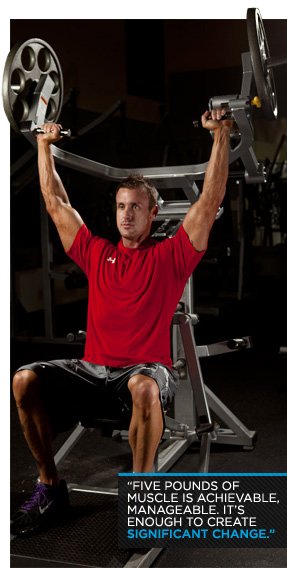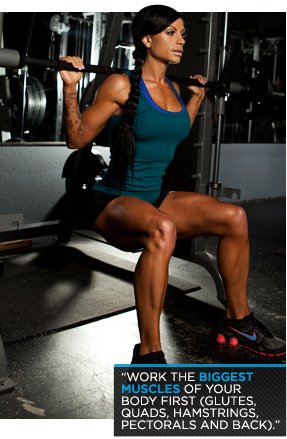Rome wasn't built in a day, and your body won't be, either. Want a realistic goal that's sure to noticeably change your physique? Start by adding five pounds of muscle.
No one can turn into a muscle-bound monster overnight, but you will look better, be stronger, and burn more body fat at rest -- all because you moved the needle on your scale five hash marks to the right.

Adding five pounds of the hard stuff is achievable, manageable, and more than enough to create significant change. These tips will help you accomplish your goals.
1 Modesty is the Best Policy
Shooting for the stars is great, but adding muscle is a marathon -- not a sprint. Anybody (and I mean anybody) has the capacity to add five pounds of muscle to their frame.
The timeline is relatively short for beginners. You can pack on the size, or get damn close, after just five weeks of training and eating for size. With just one month of exercise and solid nutrition, you'll know where you stand.
It's fine to have bigger, more ambitious long-term goals. I encourage it! I want to build 10-to-15 pounds of muscle in the next year.
But start with a stepping stone. Don't try to leap the Grand Canyon like Evil Knievel. Later, after you've added five pounds of muscle, add another five, and another...
2 Track, Don't Slack
Tracking your progress is essential to short- and long-term results. Too many beanpoles wander into the gym and start repping "curls for the girls" without an actual workout plan, clear goal, or training log. Quite simply: If you don't track your progress, you won't progress.
Measure your body fat and lean body mass before you start training, and again after you've lifted for five weeks. You can use a service like Body Fat Test, or make things really simple with skin calipers.
You should also be recording your workouts, beating your previous numbers, and taking progress pictures. Post them to BodySpace for extra motivation, accountability, and community support.
In the end, however you do it, track your workouts and your body so you know you're making progress! If you're not making progress, it's time to change the routine.

3 KISS
Keep it simple, stupid! (You're probably not stupid; it's just a saying.) Develop a simple workout routine with big lifts like the squat, bench press, overhead press and deadlift. Don't get a finicky 27-different-lifts-a-day routine with four sets for each exercise. It's not necessary in the beginning. You'll get fed up with the complexity, you won't make as much progress, and you won't build a solid foundation for future gains.
Work the biggest muscles of your body first (glutes, quads, hamstrings, pectorals and back). By training your big movers with compound lifts, you'll be able to lift safely - and heavily - in the gym.
Use a simple workout, work hard, refuel post-workout, and hit repeat. That's the best advice I have for everyone -- from beginning lifters to experienced gym rats.
4 Nutrition Rules All
Adding just five pounds of muscle requires proper nutrition! Your diet doesn't need to be perfect, but pay attention to these basic rules:
- You must be in positive caloric balance to build mass. If you want to put on weight of any kind - whether muscle or fat -- you need to eat more! That's how the mathematics of weight gain works.
- Eat your protein! You can't build new muscle without it. Good sources of complete proteins include fish, beef, chicken and any other dead animal. Milk, Greek yogurt and eggs are also great choices.
Your bare minimum should be 1 gram of protein per pound of body weight per day. For more rapid muscle gains, bump that amount up to 1 1/2 or even 2 grams per pound.
5 Take The Right Supplements
You're not going to need a barrage of supplements your first day in the gym. In the beginning, focus on eating healthfully, recovering, and performing well.
Protein powder is a must if you're going to hit the target I mentioned. Check out whey protein, which is essential post-workout and beneficial any time of the day. Multivitamins are your insurance against any vitamin deficiencies. Creatine will help maintain and build new muscle tissue, as well as increase your strength. It's okay to add more supplements as needed, once your priorities are in order and you can make good use of them.
Muscle-Building Meal Plan!
This diet plan is designed for someone who needs to eat 2,000 calories to maintain their body weight. This meal plan includes about 2,300 calories, since the person in this example is looking to put on muscle mass.

Eggs
3 eggs

Orange
1 orange

Whole Milk
2 cups
Calories: 585 | Fats: 31g | Protein: 36g | Carbs: 42g

Fat Free Milk
1 1/2 cups

Banana
1 banana

Optimum Nutrition Whey Protein
1 scoop

Honey
10 grams
Calories: 412 | Fats: 1g | Protein: 41g | Carbs: 61g

Fat Free Milk
1 cup

Blueberries
70 grams

Optimum Nutrition Whey Protein
1 scoop

Nuts
10 grams

Honey
10 grams

Kale
50 grams
Calories: 314 | Fats: 6g | Protein: 28g | Carbs: 40g

Greek Yogurt
200 grams

Raspberries
100 grams

Pecans
23 grams
Calories: 441 | Fats: 37g | Protein: 10g | Carbs: 24g

Swordfish Steak
11.2 ounces

Butter
7 grams

Carrots
100 grams
Calories: 548 | Fats: 27g | Protein: 63g | Carbs: 10g
Daily Totals
*All caloric measurements and macronutrient amounts were calculated using DietController food tracking software.
